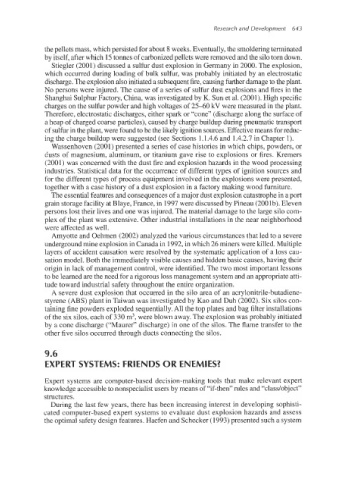Page 676 - Dust Explosions in the Process Industries
P. 676
Research and Development 643
the pellets mass, which persisted for about 8 weeks. Eventually, the smolderingtenninated
by itself,after which 15tonnes of carbonizedpellets were removed and the silo torn down.
Stiegler (2001) discussed a sulfur dust explosion in Germany in 2000. The explosion,
which occurred during loading of bulk sulfur, was probably initiated by an electrostatic
discharge.The explosionalso initiateda subsequentfire,causing further damageto the plant.
No persons were injured. The cause of a series of sulfur dust explosions and fires in the
Shanghai Sulphur Factory, China, was investigated by K. Sun et al. (2001). High specific
charges on the sulfur powder and high voltages of 25-60 kV were measured in the plant.
Therefme, electrostatic discharges, either spark or “cone” (discharge along the surface of
a heap of charged coarseparticles), caused by charge buildup during pneumatic transport
of sulk in the plant, were found to be the likely ignition sources.Effectivemeans for reduc-
ing the charge buildup were suggested (see Sections 1.1.4.6 and I .4.2.7 in Chapter 1).
Wassenhoven (2001) presented a series of case histories in which chips, powders, or
dusts o€magnesium, aluminum, or titanium gave rise to explosions or fires. Kremers
(2001) was concerned with the dust fire and explosion hazards in the wood processing
industries. Statistical data for the occurrence of different types of ignition sources and
for the different types of process equipment involved in the explosions were presented,
together with a case history of a dust explosion in a factory making wood furniture.
The essential features and consequences of a major dust explosion catastrophe in a port
grain storage facility at Blaye,France, in 1997were discussed by Pineau (2001b).Eleven
persons BQS~ their lives and one was injured. The material damage to the large silo com-
plex of the plant was extensive. Other industrial installations in the near neighborhood
were affected as well.
Arnyotte and Qehmen (2002) analyzed the various circumstancesthat led to a severe
undergroundmine explosion in Canada in 1992,in which 26 miners were killed. Multiple
layers of accident causation were resolved by the systematic application of a loss cau-
sation model. Both the immediatelyvisible causes and hidden basic causes, having their
origin in lack of management control, were identified. The two most important lessons
to be learned are the need for a rigorous loss management system and an appropriate atti-
tude toward industrial safety throughout the entire organization.
A severe dust explosion that occurred in the silo area of an acrylonitrile-butadiene-
styrene (ABS) plant in Taiwan was investigated by Kao and Duh (2002). Six silos con-
taining fine powders exploded sequentially.All the top plates and bag filter installations
of the six silos. each of 330 m3,were blown away. The explosion was probably initiated
by a cone discharge (“Maurer” discharge) in one of the silos. The flame transfer to the
other five silos occurred through ducts connecting the silos.
XPERT SYSTEMS: FRIENDS OR ENEMIES?
Expert systems are computer-based decision-making tools that make relevant expert
knowledge accessibleto nonspecialistusers by means of “if-then’’rules and “class/object”
structures.
During the last few years, there has been increasing interest in developing sophisti-
cated computer-based expert systems to evaluate dust explosion hazards and assess
the optimal safety design features. Haefen and Schecker (1993) presented such a system

